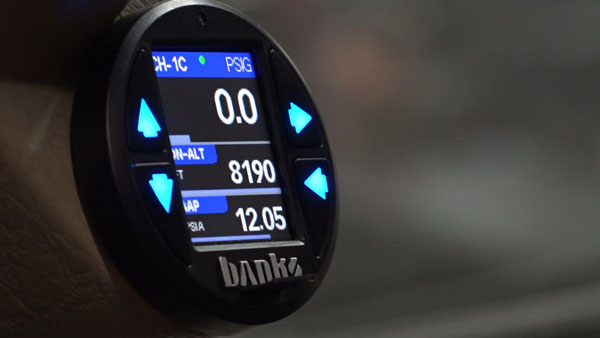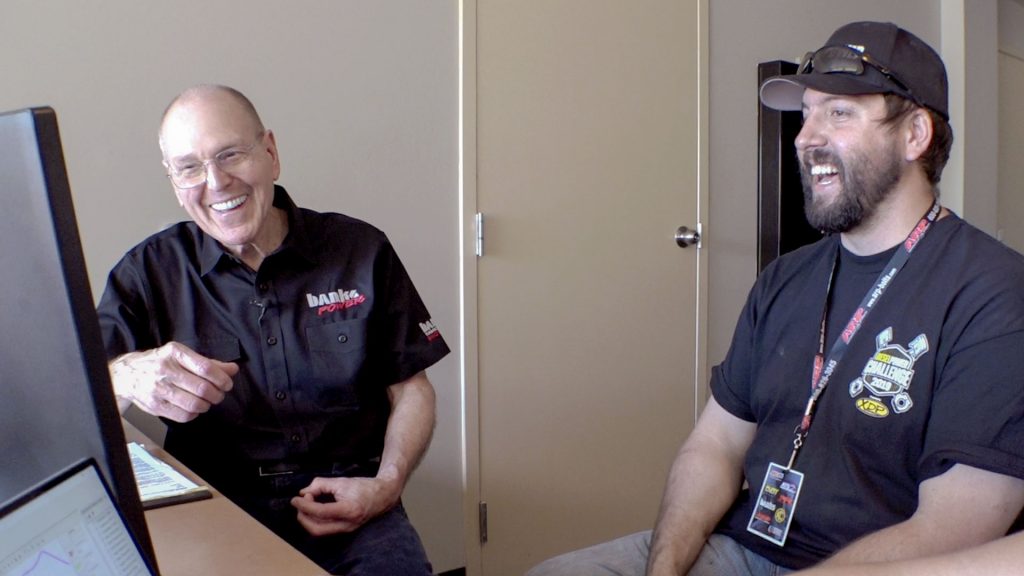Gale’s Racing Secret
“It was unreal getting to work with Gale and the Banks team at Diesel Power Challenge,” says Darin Dutton, driver of a 2009 compound-turbo’d Ford 6.4L Power Stroke. His team was one of several who met with Gale and Chris Otani, Banks’ Engineering Manager just after his 1/8 mile trailer pull last Wednesday. “DPC has been one of the best experiences I’ve had and Banks was definitely a part of making it so great.”
After every segment of DPC, Chris pulled the microSD card from each competitor’s iDash DataMonster, imported the data log into Microsoft Excel and quickly graphed the results. That data turned out to be much more powerful than anyone would have imagined. Nearly every team discovered air density (horsepower) losses in places they’d never imagined. Watch Gale reveal the data here.
Sure, there was incredible driver skill required to win each of the six segments but ultimately it was horsepower that prevailed. When it comes to dyno, drag racing, and trailer towing, horsepower wins. Manifold Air Density predicted the winners as confirmed by Richard Coker, Andrew McCane, and Seth Kuntz, the event’s first, second and third place winners.

Each Diesel Power Challenge competitor logged data using an iDash DataMonster. The data was captured by the Banks 4-channel Thermocouple Module, 4-channel Analog Module, and AirMouse, then transmitted to the DataMonster. Additionally, many competitors took advantage of extra vehicle data available on the OBD-II port.
The goal was to evaluate the performance of the air intake system, turbocharger(s) and intercooler by measuring air density changes by using pressure and temperature sensors. With that data, the teams would know what each component was adding or subtracting to the system’s overall air density. While many teams had faith their intercoolers and turbos were performing admirably, the data told a different story.

Richard Coker, for instance, had no idea how much heat his turbos were adding to the air before entering the intercooler. When Gale showed him that his compressor outlet temperature was 685° his mind was blown. Of the two turbos in his compound system, the outlet temp of the first compressor was 496°. This highlights the importance of having intercooling between the two compressor stages. Doing so would have reduced the temperature into the second compressor by over 300°. This would also result in a significantly reduced outlet temp on his second compressor. The lack of intercooling resulted in lower Manifold Air Density which meant the air in the cylinders was far less dense and therefore leaving horsepower on the table. Richard now knows that if he adds intercooling between the turbos, he stands to make even more power than his Duramax’s already impressive 1,190 (uncorrected) horsepower.

And that’s not all. Richard was using what be believed to be the most effective intake air system possible; a massive bell-mouth inlet with no filter. He’d surmised that by removing the right headlight, that cool outside air would flow right through the headlight opening and into the giant bell-mouth intake. Much to Richard’s surprise, Gale revealed that his intake was actually losing 8% air density. The two decided that Richard would extend the intake tube through the headlight opening, with the bell-mouth inlet mounted in front of the truck’s grill thereby capturing cool outside air, rather than breathing in hot under-hood air. Gale has been talking about the ills of hot under-hood air for years and Richard’s data provided undeniable proof that heat kills power.
Want to know more about your engine’s performance? Check out the iDash DataMonster.

